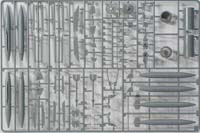
Kinetic 1/48 F-104A/C Starfighter Kit First Look
By Michael Benolkin
| Date of Review | October 2021 | Manufacturer | Kinetic |
|---|---|---|---|
| Subject | F-104A/C Starfighter | Scale | 1/48 |
| Kit Number | 48096 | Primary Media | Styrene |
| Pros | Nice kit and decals | Cons | See text |
| Skill Level | Experienced | MSRP (USD) | $39.99 |
First Look
 |
 |
 |
 |
 |
Less than five years after Chuck Yeager broke the sound barrier, Clarence 'Kelly' Johnson was looking at the first combat experience between jet fighters over the skies of Korea and understood the need for an aircraft that could reach high altitude and affect a high-speed intercept to achieve and maintain air superiority. His revolutionary Model 83 was designed to meet that need and was submitted to the USAF as an unsolicited proposal. The Air Force agreed with the need but decided to seek other ideas from industry. Designs were submitted by Republic and North American, but a cautious Air Force staff opted for the Lockheed design. The F-104 was born.
Two XF-104s were delivered less than two years later, but the first production F-104As would not enter service until early 1958. The F-104 was the first operational aircraft to fly above Mach 2 (twice the speed of sound). Its small airframe enclosed a powerful afterburning J79 engine which could take the F-104 from the ground to 80,000 feet in less than five minutes. The F-104A entered service in 1958, but as the service gained experience in the type, Air Force planners realized that the F-104 had limited range/endurance and payload which ran counter to the service's evolving mission. The F-104A was transferred from the Tactical Air Command to Air Defense Command where a rapid-response point-defense fighter would be more suitable. In what seemed like a good idea at the time, Lockheed adopted a downward firing ejection seat out of concerns that the T-tail would hit a pilot during ejection, but the growing fatalities from failed ejections led Lockheed to replace the downward-firing C1 seat with the upward-firing C2 set. Even so, the aircraft had a minimum speed of over 100 knots in order for that seat to properly work. This lead to NATO operators of the Starfighter to replace the C2 with a Martin-Baker Mk.7 which could safely eject a pilot while on the ground (zero-zero - zero airspeed/zero altitude).
As the Air Force began operations in Southeast Asia in the early 1960s, they also realized their primary fighter, the F-100, was also unsuitable for air superiority as it lacked a radar to engage MiGs operating out of North Vietnam. The fighters that did have radar at the time did not have guns or self-sealing fuel tanks, so the newly delivered F-104Cs were deployed to provide cover for fighter-bombers going north. The F-104Cs employed aerial refueling to extend its range but didn't achieve any aerial victories during these operations as the North Vietnamese knew of the F-104's capabilities and did not engage them. Nevertheless, the deterrent value of the aircraft kept aircraft they did escort safe from enemy intercepts.
A few years ago, Kinetic Models first released their 1/48 F-104G kit in their Gold Series, and here is their latest: the F-104A/C. The kit is molded in light gray styrene and presented on three parts trees plus one tree of clear parts and one small fret of photo-etched details. Among the features and options in this kit:
- Nicely detailed downward-firing C1 ejection seat with photo-etched pilot restraints
- Nicely detailed cockpit
- Positionable canopy
- Detailed afterburner section and J79 nozzle
- Detailed landing gear and wheel wells
- Detailed avionics bay with positionable door
- Positionable rudder
- Positionable stabilator
- Positionable ailerons
- Positionable leading edge flaps
- Positionable trailing edge flaps
- Positionable speed brakes
- Positionable main landing gear doors
- Optional air refueling probe
External stores options include:
- 2 x AIM-9B Sidewinder
- Dual rail Aero-3B missile rack for under fuselage
- 2 x wingtip tanks
- 2 x underwing tanks
The kit includes one sheet of decals which provide the following options:
- F-104C, 57-0928, 435 TFS/479 TFW, Udorn RTAFB
- F-104C, 56-0938, 198 TFS/PR ANG
- F-104C, 56-0906. 434 TFS/479 TFW, George AFB
- F-104C, 56-0908, 434 TFS/479 TFW, George AFB (mis-identified as F-104A in the instructions)
The decals provide a nice set of airframe stencils which are printed by Cartograf.
A few notes worth considering:
- The instructions provide color information using Mig equivalents (again) though a cross-reference table is provided
- The color profiles are printed in black and white, so good luck sorting out colors unless you have other references. Please print color profiles in color and declutter the instructions with simple paint numbers/letters and not Ammo/Mig labels
This is the first kit produced that can build into an accurate early-model F-104, right down to the frangible floor in the cockpit for the downward firing seat. While some might believe that the Hasegawa kit was good in 1/48, you haven't seen the DACO conversion that replaces nearly every part in the Hasegawa box in order to render a proper F-104 in any variant. Kinetic has really come a long way since their first release and this kit is easily the best Starfighter kit in any scale. The retail price remains the same as last year's single-seat release, $39 USD (plus shipping) if purchased from Lucky Model.
My sincere thanks to Lucky Model for this review sample!
W






